#labridae
Text

A male slingjaw wrasse (Epibulus insidiator)
by Alain Feulvarch
#slingjaw wrasse#wrasses#bony fish#fish#epibulus insidiator#epibulus#labridae#labriformes#actinopterygii#chordata
1K notes
·
View notes
Note
🥚💕
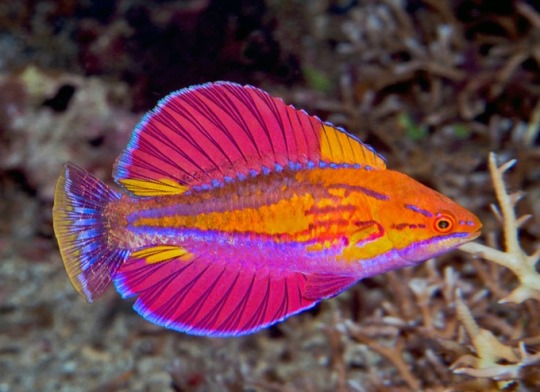
Carpenter's flasher wrasse!
(Paracheilinus carpenteri)
839 notes
·
View notes
Text
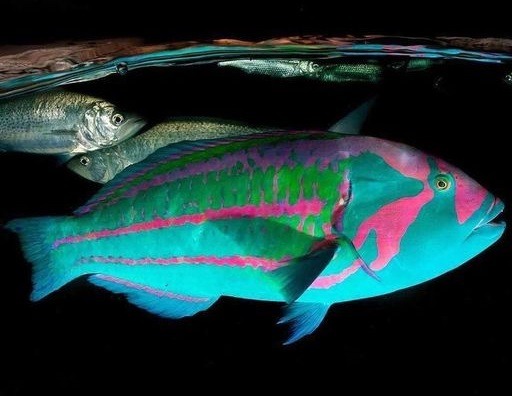
Surge Wrasse (Thalassoma purpureum), family Labridae, order Labriformes, Lord Howe Island, Australia
These fish are protogynous hermaphrodites. They all hatch out as females, and turn into males later in life.
photograph by Jordan Robins
249 notes
·
View notes
Text

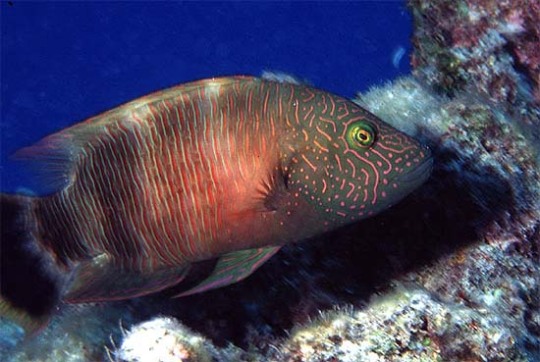
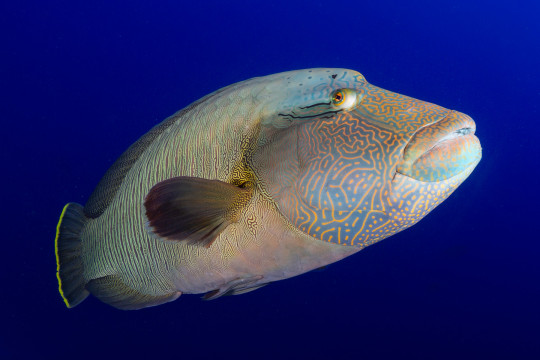
Let's Hear it for the Humphead Wrasse
The humphead wrasse, Cheilinus undulatus, is also known as the Māori wrasse, Napoleon wrasse, or the blue- tooth grouper. They can usually be found around coral reefs and steep rocky cliffs in the Indo-Pacific, particularly on the east coast of Africa, the west coast of India, and the tropical waters of southeast Asia and the Great Barrier Reef.
The Māori wrasse gets its name from the distinctive markings that adults carry. Males are blue-green or purple, while females are more often red or orange. Both have unique patterns of lines and dots covering their heads, and stripes running down the rest of their body; early researchers compared the patterns on their heads to the tattoos traditionally used by the Māori people. In addition to its striking coloration, C. undulatus is also known for being the largest member of the wrasse family. Males can reach up to 2 m (6.5 ft) long and weigh up to 180 kg (396 lbs), while females tend to be smaller. Males also have a large 'hump' on their foreheads, hence the name humphead wrasse.
Another feature of note in C. undulatus is the set of large teeth fused into a parrot-like beak. They use this beak to predate upon hard-shelled animals like mollusks, urchins, sea stars, and crustaceans. On occasion, they also feed on smaller fish and moray eels. Due to their size, adults have very few natural predators aside from sharks, but larvae and small juveniles are more often opportunistically hunted by other fish.
Like many coral reef fish, the humphead wrasse is a protogynous hermaphrodite. This means that most individuals begin life as a female, and become male later in life-- known as 'super males', they are larger than males who did not transition. Individuals first become sexually mature at 5-7 years old, and females begin transitioning to male at 9-12 years old. Spawning occurs a few times a year, and during this period over a hundred adults can congregate in an area. The female releases about 20 eggs into the water column, where they are fertilized by her chosen partner. Three to four weeks later, the eggs hatch and the larvae migrate to the nearby reef.
Conservation status: C. undulatus is considered Endangered by the IUCN. Populations have declined due to overfishing and by-catch mortalities, loss of their food sources, habitat destruction, and capture of juveniles for the aquarium trade.
If you send me proof that you’ve made a donation to UNRWA or another organization benefiting Palestinians– including esim donations– I’ll make art of any animal of your choosing.
Photos
Andrew J. Green
Lluís Masuet
George Ryschkewitsch
#humphead wrasse#Labriformes#Labridae#wrasses#ray-finned fish#bony fish#fish#marine fauna#marine fish#coral reefs#coral reef fish#indian ocean#Pacific Ocean#indo-pacific#animal facts#biology#zoology#ecology
99 notes
·
View notes
Photo
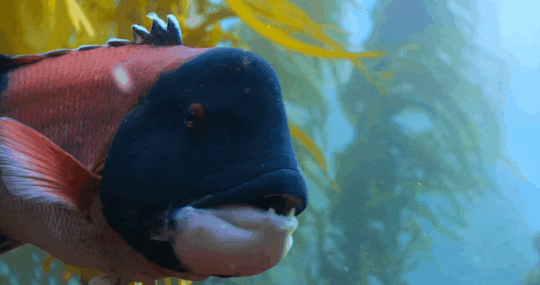
california sheephead (semicossyphus pulcher)
one of the largest members of the wrasse family, the california sheephead is a vital part of kelp forest ecosystems. they prey on shelled creatures, which includes sea urchins, who are kelp grazers. their large teeth allow them to crush through the shells of their prey. they are protogynous fish and often travel in a harem - with one dominant male leading a group of females.
this species is listed as vulnerable on the IUCN red list.
gif creds: our planet (2019)
#zoology#biology#marine biology#ichthyology#osteichthyes#actinopterygii#wrasse#labriformes#labridae#fish#vulnerable species#our planet#california sheephead
197 notes
·
View notes
Text
#1965 - Bodianus unimaculatus - Red Pigfish
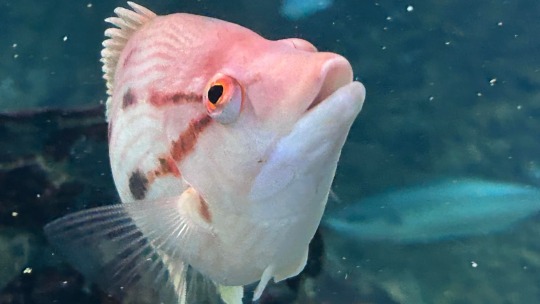
AKA red hogfish, eastern pigfish, Banded Pigfish, Black-spot Pigfish, Eastern Blackspot Pigfish, and Reddish Blackspot Pigfish.
photo by @purrdence
A species of wrasse (Labridae) native from eastern Australia to New Zealand, including Lord Howe Island, Norfolk Island, and the Kermadec Islands. They live in coastal reefs and offshore waters down to a depths of about 60m.
Males of this species can reach half a meter in size, while females only reach 30 cm.
I don’t know why they’re called pigfish - there are certainly other unrelated fish with the same common name that can grunt loudly when distressed by grinding their pharyngeal teeth together, but I don’t know if these do.
... oh. They’re pink and have a snoot. Of course.
2 notes
·
View notes
Text
She Wanted to Wet an Entire Bed With Her Squirting Loads and MyLord Almost Got Drowned on It
English Lessons with hot twins
Indian Gay Pink Lips Hot Kiss
Hot indian sexy gaand on market
latina hot pussy
Safada gozando no pau de borracha
Delhi bhabhi fucked in hotel on table
Big ass teen Scarlett Mae gets her pussy fucked by her bf
japanese milf widow masturbating
Fuck in running train girl on top
#discommode#intrapontine#astrology#clong#misparsing#equipages#Labridae#millinerial#Blandville#twirk#fluoridated#joint#raine#reffo#neuroanatomy#nivellate#Teutondom#anisochromatic#bacteriorhodopsin#moodle
0 notes
Text
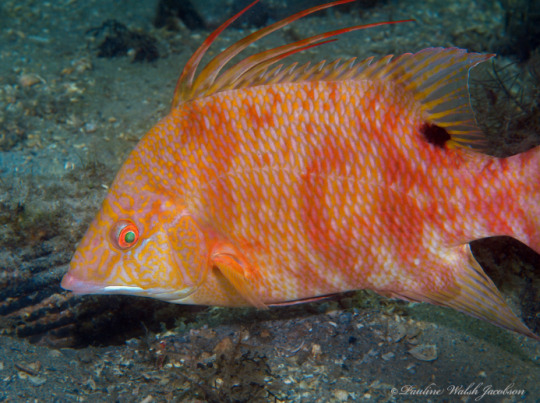
Hogfish (Lachnolaimus maximus)
Family: Wrasse Family (Labridae)
IUCN Conservation Status: Vulnerable
Named for its elongated snout which it uses to root through sediment in search of crabs and other seabed-dwelling prey, the Hogfish is a unique species of wrasse native to the western Atlantic Ocean, where it mainly inhabits areas near coral reefs (particularly reefs dominated by soft corals.) All Hogfishes are born as females, but as they progress through their lives some may develop into males upon reaching older age; members of this species live in small schools consisting of numerous small females and a single large male (which can be distinguished from the females around him by his larger size, darker colouration, longer fin spines and the distinctive black spot near the base of his tail,) responsible for fertilizing all the group's eggs, and in the event of the school's male dying or otherwise being separated from the rest of the group the largest, oldest remaining female will lose the ability to lay eggs, increase in size, develop the colouration of a male and gain the ability to produce sperm, taking his place. In addition to changing in colouration when changing sex, Hogfishes are also known to be capable of changing colour in order to avoid detection by predators (taking on duller colouration to match their surroundings upon spotting predators such as Sand Tiger Sharks,) and surprisingly it seems this colour-changing ability is managed purely by the chromatophores (colour-changing cells) in their skin with little input from the brain, as the skin will continue to change colour to match its surroundings for a short period even after being removed from the fish's body.
--------------------------------------------------------------------------
Image Source: https://www.inaturalist.org/taxa/49432-Lachnolaimus-maximus
#Hogfish#hogfish#wrasse#wrasses#zoology#biology#icthyology#marine biology#animal#animals#fish#fishes#marine wildlife#north american wildlife#wildlife#bony fish#bony fishes
145 notes
·
View notes
Text
what’s up, doc?
medic!gn!reader
summary : coming from a long line of proficient healing magic-users, a letter requesting for your presence as nrc’s nurse is sent to your household, rather than the ebony carriage.
or ; headcanons and scenarios on what it’s like being nrc’s only medical staff surrounded by idiots who only know how to get hurt.
a/n : reader is implied to be the same age as the current third-years (18) and entered the school the same time as said third years.
‘labridae’ - is a fish that is well known for their role in the removal of parasites from larger carnivorous fishes. The larger fishes recognize the cleaner fish and will not devour it.

you were a fool to think that nrc was as prestigious as the rumours implied. your first day consisted of a meeting with the school’s seemingly incompetent principal and excited first years who though it was okay to roughhouse.
“with all due respect, headmaster, how am i supposed to be an apprentice if there is no one for me to learn from?” crossing your arms expectedly, you raise a questioning eyebrow at the old crow in front of you.
“your family are known to be quite knowledgeable in the art of healing, so i took it upon myself to be a gracious and thoughtful principal and saw this as a learning experience for their next heir! it’s quite convenient since the last nurse up and left, and perhaps i could even gain some connections…” sticking his nose in the air, he huffs proudly.
“what was that last part? i couldn’t hear you.”
“well, i am a very busy person, mx. medic, so i best be off!”
“wait-”
your specialised uniform consists of the classic blue scrubs underneath the standard lab coat of an nrc student, although, the only difference being that it doesn’t come with gloves and has a white armband engraved with a bold red plus symbol where a dorm insignia would be presented.
during your first year at nrc, you learn quickly that students don’t take too well with people who stick out too much, finding yourself often cornered by a group of people who think they’re tough and want to establish some sort of dominant image. but after just a few incidents, the students learn not to bother you too much.
“you think you’re so much better than the rest of us just because you were personally requested by the principal to attend, don’t’cha?” a student grips onto the collar of your shirt and lifts you to reach their face, the tips of your shoes being your only contact with the ground.
“i may be younger than you lot, but i am part of the faculty of this school, therefore, i am authorised to perform actions of discipline when and how i see fit. so, i highly suggest that you let me go or else you won’t have anyone to patch you up after i’m finished with you.”
the infirmary is located in a very secluded hallway from the rest of the school, so few students have taken upon themselves to use it as a safe area, away from the bustle and hustle of energetic and hectic students. and of course, who were you to say no?
“idia, i know i said that i’ll welcome you with open arms when you feel that your social battery is low and want someplace to hide, but for the third year in a row, that doesn’t mean i’m allowing you to modify the corner bed as your personal ‘recharge zone’, what happens if i need to treat someone?”
opening a packet of a candy mix, you tip them into a large, transparent jar. you laugh quietly when you hear the rapid pressing of his game console and sound effects of his game lower in volume by just a little. idia may seem uninterested in conversation most of the time, but you noticed that he gains a bit more confidence when talking with you.
“of course npcs like you wouldn’t understand, fuhehe. the ultra-rare, once in a lifetime healing stats you put in this place is out of this world.” without looking away from the game, he reaches out and makes grabbing motions at you. letting out a silent sigh, you begrudgingly drop two bits of hard candy into the palm of his hand. not wasting any time he throws them into his mouth and bites down into them.
“the internet connection is decent considering this place is in the middle of nowhere; the corner bed has five sockets along the wall rather than just two like the other beds; you bring me actual meals if i stay long enough and you also fill the sweets jar with the top quality stuff you only find in the easter egg shops the game devs add in limited edition events. it’s basically an easy win lol.”
if the botanical garden is for some reason not available then leona also takes refuge in your work space.
“instead of actively skipping classes, why don’t you try passing this year first, leona?”
“haah?? who do you think you are? i’ll crush you, small fry.”
you started to give your patients sweets after patching them up because you know lots of people find receiving medical treatment very uncomfortable. but now it kind of backfired since now everyone expects a little treat after being such a ‘big boy.’
“i can’t give you double the sweets just because you didn’t complain about me not having fish shaped plasters this time, floyd.” you hand him the usual: two green-apple gummy snakes.
“but labridae-senpai, i’ve been extra good today!” he pouts and whines while gripping the sweets in his hands, seemingly choking the snakes. your eye twitches slightly.
“i’ll give you just one more but that’s it.”
“yay!”
vil definitely asks for your input when trying new products for his skin or diets. he values your opinion because of your knowledge in nutrition. vil knows that you’ll be truthful and won’t reply with answers he’d only like to hear.
“vil, i know you want to reduce your fat intake for an upcoming photoshoot but i highly suggest you don’t cut out oily fish from your diet by this much, it’ll affect your academic performance.” you squint at the words on the sheet of paper containing vil’s suggested diet for the next few weeks, thinking of alternatives.
“hmm, yes, i was thinking the same thing but i was wondering if you could recommend some omega-3 vitamins, just temporarily so that it doesn’t hinder my performance that much,” the dorm leader proposes.
a light switches on in your head, grabbing a scrap piece of paper, you scribble a message onto it, “mhm, go to any pharmacy and request for ‘maritime drops,’ show them this paper and you should get the capsule for free. they can get a bit pricey depending on how fresh the batch was.”
you once heard the rumours of vil’s glowing skin during the opening ceremony and immediately knew the culprits of such a result. said culprits take up quite the percentage of causes of injury amongst the students on campus. could be because someone broke a deal or someone disagreed with the result of a deal. in your head, you thank the octatrio for keeping you busy with the people they slightly harm- but that’s besides the point. you doubt vil nor azul has any easy access to ingredients found only on the seabed seeing as you need special permission from the principal to exit school grounds, so that only leaves you with one other rather unfortunate theory.
you can only imagine what kind of odd payment a certain sneaky octopus has asked for in return…
“azul, please don’t tell me you wrung dry one of your mer-dorm members.” you note how azul’s office lacks one of the leech twins and you can only pray for floyd’s recovery (and for your candy stash because you just know he’ll be demanding them the next time he steps into your office).
“don’t worry, medic-san. floyd is making steady progress in rehabilitation,” azul smiles at you with no real feeling behind it.
you deadpan while sighing in exasperation, “here, give him this.” fishing through your deep pockets, you place down a small bottle filled with a fluorescent purple liquid on azul’s desk. looking towards jade’s direction you inform him, “tell floyd to bathe with three droplets of this stuff once a day and he should be able to walk again… eventually.”
the adeuce duo are lowkey kind of scared of you, especially after the dwarf mines incident during the first day.
“i get that you guys were gonna get expelled and all but couldn’t this wait until it was morning? as you said, none of you got hit in the head or found to be bleeding that much,” sending a small glare at the kneeling boys who you patched up first before demanding an explanation why they woke you up at the ass crack of dawn to have a check up.
“medic-senpai, isn’t it kind of your job to look after us no matter what?” yuu, the magicless now-student pipes up from a nearby chair, defending the duo, with a large rat-cat-thing dangling in their arms, snoring. it looks kind of gross.
“wanna say that again?” you ask expectedly. it was too early in the morning to argue too much.
“n-nothing…”
pinching the bridge of your nose, you throw them each a lollipop, “run along now, inform your housewarden that you’ve got an excusal from me.”
your family owns a few hospitals so you already had extensive knowledge on medicines and the such but what you lacked most of all was experience. so while you don’t regret attending nrc, you sometimes get tired of the same routine: students enter with scratches and bruises, you patch them up, give them sweets, send them off. you wished something more interesting would happen.
fine, if crowley wasn’t going to offer you proper education or enjoyment then you may as well do it yourself.
because of your seemingly lackadaisical attitude and nonchalance, people often mischaracterise you as somewhat friendly and forgiving just because you’re the medic.
when in reality, you’re just as bad, maybe even slightly worse than most of nrc’s students. hidden behind reassuring expressions and pretty words, you’re quite the cunning and sneaky one.
unbeknownst to the students and staff (besides crewel, he actually encourages it-), you experiment with them, testing out new concoctions or herbal treatments you’ve made constantly. how else are you supposed to earn the title of your family’s next heir if you couldn’t perform such a feat? the students all assume that it’s under the pretense that it has already been tested and sold to the public.
“don’t worry, this medication doesn’t have long lasting side effects. …probably.” smiling eerily at your unsuspecting patient, you scoop a portion of a bubbling green mixture and bring the spoon to their mouth, “cmon, say aah~”
nrc can only stand and watch in fear as you have a field day with all the recent overblots, riddle unfortunately being the very first victim to your questionable praise.
“now look to the left… mhm, no blot in your eyes either.” pocketing your retinoscope, you nod towards riddle, “you’re all good, no signs of leftover blot in your system but i would like for you to come to the infirmary for a regular check up before and after school for a week.”
“thank you, medic. i deeply apologise for the trouble i have caused for you.”
“no need to apologise, actually!” you wave him off.
riddle and a few other heartslabyul members within earshot look at you as if you’d grown a third head.
“look at all the damage you’ve caused, riddle. i really couldn’t thank you enough! here, have a lollipop, it’s strawberry and vanilla flavoured- oh, i can not wait for my clinic to flood in with students. things were getting ever so quiet! so many test subjects, so little time- i wouldn’t even know where to start~♡” with your eyes swirling with hidden craze, you swoon at the mass destruction that was once the heartslabyul garden, you can only imagine the number of scratched up students waiting in line at your door.
“psst- why is doc acting like that?”
“when they get like this, it’s best to just not say anything, ace…”

head empty, no thoughts. only caring for the twst boys-
just imagining being able to take proper care for the boys makes me brainrot so much 😭
#twisted wonderland#twst#twst x reader#medic!au#reader insert#gender neutral!reader#gn#twisted wonderland x reader#very self indulgent
2K notes
·
View notes
Text
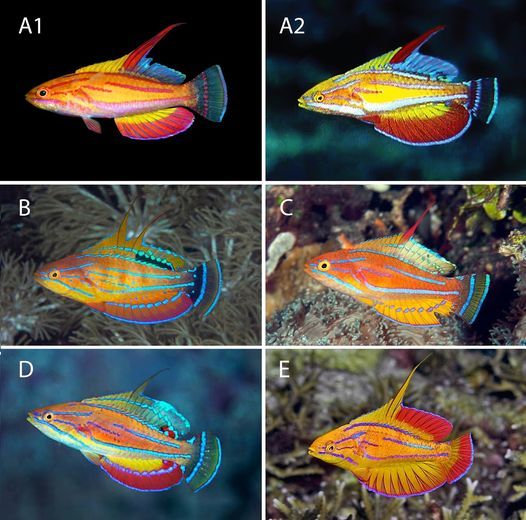
Review of Australian Species of Paracheilinus Fourmanoir (Teleostei: Labridae), with Description of a New Species from the Great Barrier Reef and Coral Sea
#FlasherWrasses
Yi-Kai Tea, Fenton Walsh
Abstract
Australian species of the cirrhilabrin labrid genus Paracheilinus are reviewed.
Four species of Paracheilinus are reported from Australian waters: P. amanda, new species, from Flora, Holmes, and Osprey Reefs, Coral Sea, off northeast Queensland, and Harrier Reef, Great Barrier Reef; P. filamentosus from Lizard Island, Great Barrier Reef; P. flavianalis from Evans and Flinders Shoals, Timor Sea, off northeast Darwin, Northern Territory, and Ashmore, Scott, Seringapatam, and Hibernia Reefs in the north-western shelf of Western Australia; and P. nursalim from Flinders Shoal, Timor Sea, off northern Darwin, Northern Territory.
Paracheilinus amanda, new species, has previously been confused for P. rubricaudalis from Melanesia, but molecular analysis of mitochondrial COI recovers both species as reciprocally monophyletic lineages, differing from each other by 1–1.2% in genetic distance.
They further differ in aspects of live coloration of terminal phase (TP) males. Both species are allopatric and do not overlap in distribution. The new species is described on the basis of six specimens: the holotype and two paratypes from Harrier Reef, Great Barrier Reef, one paratype from Flora Reef, Coral Sea, and from two paratypes collected off Hula in southern Papua New Guinea, along the north-western margin of the Coral Sea.
The discovery of P. nursalim in Australia represents a new and significant range extension from previous locality records of West Papua and Ambon Bay.
Paracheilinus is rediagnosed, and keys, diagnoses, photographs, and Australian distribution records are presented for all species herein.
Read the paper here:
Review of Australian Species of Paracheilinus Fourmanoir (Teleostei: Labridae), with Description of a New Species from the Great Barrier Reef and Coral Sea (bioone.org)
103 notes
·
View notes
Text
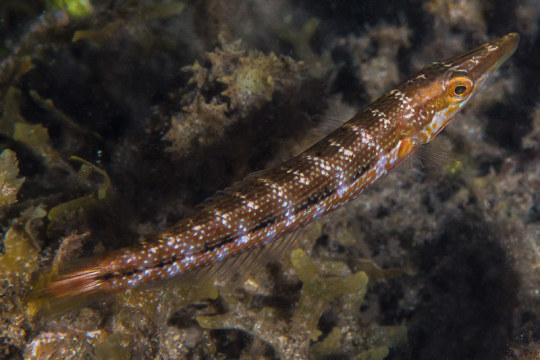
A cigar wrasse (Cheilio inermis) in Tahiti, French Polynesia
by François Libert
#cigar wrasse#wrasses#bony fish#fish#cheilio inermis#cheilio#labridae#labriformes#actinopterygii#chordata#wildlife: tahiti
38 notes
·
View notes
Text

California Sheephead (Semicossyphus pulcher), family Labridae, Channel Islands National Park, California, USA
* These large wrasse are protogynous hermaphrodites. They all start off their life as females, and some of them become males when they are older.
Photograph via: National Park Service
309 notes
·
View notes
Text
Animal Crossing Fish - Explained #233
Brought to you by a marine biologist who uses tools to get shit done...
CLICK HERE FOR THE AC FISH EXPLAINED MASTERPOST!
If you're familiar with the debate surrounding animal intelligence, you've probably heard about the many tests animals can be given to test their level of intelligence. These tests are how we have determined that dolphins and great apes are smart as hell while most other animals really aren't. Now, we don't have a lot of time to talk about intelligence, but please understand that intelligence, like any trait, is useful for some but not for others, and that doesn't make those others lesser. Anyway, one test for intelligence is the use of tools, and today's fish - the Blackspot Tuskfish - was the first fish discovered to do just that.
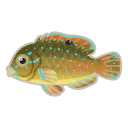
The Blackspot Tuskfish (acronym from now on - BSTF) appeared for a short while in Animal Crossing Pocket Camp for their Fishing Tourney #53, the Oasis Patio. This event occurred during August 2022, and the BSTF hasn't been seen since.
The BSTF is a species of wrasse belonging to Order Labriformes which includes the wrasses, parrotfish, and cales. These fish are most often associated with coral reef habitats and feed on a variety of organisms and algae, depending on species. Within Labriformes is Family Labridae which are the wrasses specifically. They are known to be incredibly colorful, and most are protogynous hermaphrodites, meaning they begin life as females and become male as they grow larger. Some, like the tuskfish (Genus Choerodon), have large, sharp teeth - "tusks" - and powerful jaws they use to crunch on bivalves and other hard prey. The BSTF (Choerodon schoenleinii) is a native to Indo-Pacific near-shore coral reefs, from East Africa out to various Pacific islands, where it does just that.

From https://fishesofaustralia.net.au/home/species/1928
When the BSTF finds a bivalve is just can't crack with its jaws alone, it goes looking for something to help it, like a rock it can smash the bivalve into. In July 2011, this behavior was finally documented, providing evidence to support the notion that wild fish can use tools. At least for BSTF, it was given that seal of approval, as using the rock to help it feed fit the accepted definition of tool use.
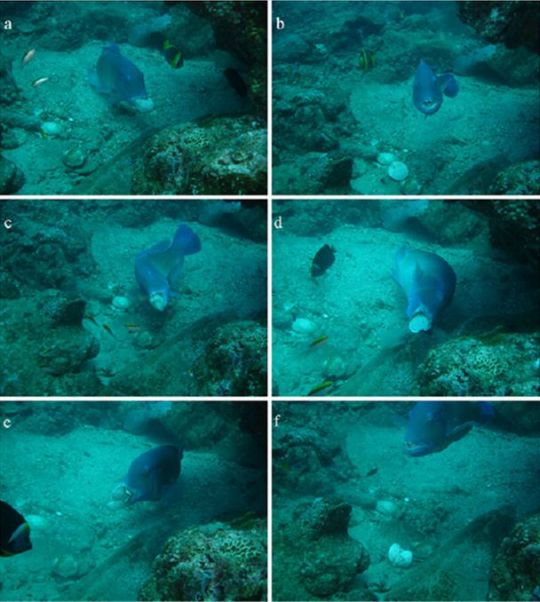
From https://phys.org/news/2011-07-photo-fish-tools.html
Fish are smarter than people give them credit for. At the end of the day, it's really hard to determine how smart a creature like a fish, that has evolved over millennia in an environment so unlike ours, is. We can't simply compare their intelligence to ours, nor should we snub our noses at animals that just don't have it. You wouldn't like it if a fish judged you based on how well you could breathe underwater.
And there you have it! Fascinating stuff, no?
#blackspot tuskfish#fish#animal crossing#animal crossing pocket camp#acpc#animals#marine biology#ocean#science#science in video games#animal crossing fish explained
4 notes
·
View notes
Text
Marine creatures in coral reef ecosystem

Credit: Raavya Bhattacharyya
Hi. This is the fourth entry in the series of blogs about coral reefs. In this blog, we will look at the various fantastic marine creatures in the coral reef ecosystem. More than thousands of marine life interact with coral reefs, but we will only see some of them in the blog. Let's start exploring them.
Coral-feeding fishes
In addition to shelter and living spaces, corals are the food source of coral-feeding fishes (also known as corallivorous fishes) (Cole, Pratchett & Jones 2008). Among 128 corallivorous fishes from 11 families documented, 69 belong to the family Chaetodontidae. Other families include the Balistidae, Labridae, Monacanthidae, Pomacentridae, Scaridae and Tetraodontidae. Below are examples of fish species of the mentioned families. Some are not coral-feeding fishes. The pictures just show how the species will look in a particular family.
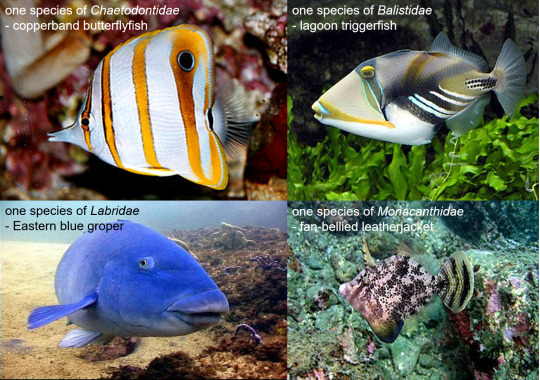

Credit: Wiktionary (Chaetodontidae); Wikipedia (Balistidae; Monacanthidae; Pomacentridae; Scaridae; Tetraodontidae); Tim Hochgrebe (Labridae).
One-third of them almost feed only on corals, which make up more than 80% of the diet. Regarding feeding preference, some ingest the live coral tissue (e.g., coral polyps, coral mucous, coral skeleton), while some prefer the dead tissue (e.g., dead coral skeletons). For instance (Cole, Pratchett & Jones 2008):
coral polyps - chevron butterflyfish, Chaetodon trifascialis, Chaetodontidae
coral mucous - ornate butterflyfish, Chaetodon ornatissimus, Chaetodontidae
live coral skeletons - guieneafowl puffer, Arothron meleagris, Tetraodontidae
dead coral skeletons - scraping scarids

Credit: Francois Libert (chevron butterflyfish); Jim Nelson (ornate butterflyfish); Charlotte B (guieneafowl puffer); One People One Reef (scraping scarids)
This chronic predation can help regulate the abundance, distribution and fitness of some coral prey (Cox 1986; Rotjan & Lewis 2005; Rotjan et al. 2006). For instance, the selective predation of the coral-feeding fish Chaetodon unimaculatus on the corals Montipora verrucosa affects the coral growth, zonation and competitive ability (Cox 1986).
Coral groupers and trouts and their hunting partners
Coral groupers Plectropomus pessuliferus marisrubri and coral trouts Plectropomus leopardus feed on small fishes in the coral reefs (Vail, Manica & Bshary 2013). However, due to their relatively large body size, they cannot enter the coral reefs to conduct predation. Therefore, they cooperate with the hunting partners (Vail, Manica & Bshary 2013). For instance, the coral groupers Plectropomus pessuliferus marisrubri partner with the giant moray eel Gymnothorax javanicus and the Napoleon wrasse Cheilinus undulatus in predation (Bshary et al. 2006). The coral trouts Plectropomus leopardus hunt collaboratively with the octopus Octopus cyanea (Vail, Manica & Bshary 2013). The hunting partnership is beneficial as it increases the predation rate.
Collaborative hunting tactics (Bshary et al. 2006; Vail, Manica & Bshary 2013):
Coral groupers and trouts - indicate location of hidden prey in coral reefs to hunting partners and capture chased prey in open water using burst speed
Hunting partners:
Giant moray eels - have slender body to enter the coral crevices
Napoleon wrasses - have protractile jaws to suck out hidden prey or smash the reef matrix around the prey
Octopuses - have long arms to capture prey in cervices


Credit: Georgette Douwma (Plectropomus pessuliferus marisrubri); Graham Edgar (Plectropomus leopardus); Luis Pérez Berrocal (Gymnothorax javanicus); Giuseppe Mazza (Cheilinus undulatus); Age Fotostock/Alamy Stock Photo (Octopus cyanea )
Flamingo tongue snail
Flamingo tongue snails (Cyphoma gibbosum) are gregarious sea snails that are found on the gorgonian corals, which possess distasteful toxins to protect them from being eaten (Whalen 2008). These tiny creatures are smaller than a postage stamp. Unlike most marine animals, they like to eat the gorgonian corals. They munch the toxin-saturated tissue until the hard skeleton of gorgonian corals using radula (modified tooth). One unique feature is that they can exploit the gorgonian toxins and incorporate them into the flaps of their brightly coloured mantle to make them awful to be eaten by fish (Whalen 2008).
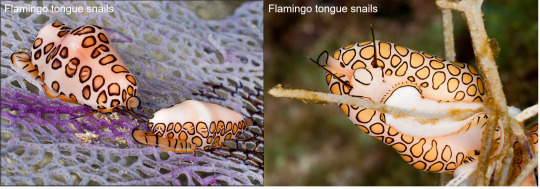
Credit: Linda Ianniello
This is the end of this blog. I hope these fantastic marine creatures in the coral reef ecosystem have amazed you.
References
Bshary, R, Hohner, A, Ait-el-Djoudi, K & Fricke, H 2006, ‘Interspecific communicative and coordinated hunting between groupers and giant moray eels in the Red Sea’, PLoS Biology, vol. 4, no. 12, p. e431.
Cole, AJ, Pratchett, MS & Jones, GP 2008, ‘Diversity and functional importance of coral‐feeding fishes on tropical coral reefs’, Fish and Fisheries, vol. 9, no. 3, pp. 286-307.
Cox, EF 1986, ‘The effects of a selective corallivore on growth rates and competition for space between two species of Hawaiian corals’, Journal of Experimental Marine Biology and Ecology, vol. 101, no. 2, pp. 161-174.
Rotjan, RD, Dimond, JL, Thornhill, DJ, Leichter, JJ, Helmuth, B, Kemp, DW & Lewis, SM 2006, ‘Chronic parrotfish grazing impedes coral recovery after bleaching’, Coral Reefs, vol. 25, pp. 361-368.
Rotjan, RD & Lewis, SM 2005, ‘Selective predation by parrotfishes on the reef coral Porites astreoides’, Marine Ecology Progress Series, vol. 305, pp. 193-201.
Vail, AL, Manica, A & Bshary, R 2013, ‘Referential gestures in fish collaborative hunting’, Nature Communications, vol. 4, no. 1, p. 1765.
Whalen, K 2008, ‘Biochemical warfare on coral reefs’, Oceanus, vol. 47, no. 1, p. 13.
Images or videos from external sources:
Age Fotostock/Alamy Stock Photo - https://www.worldwildlife.org/magazine/issues/spring-2019/articles/meet-the-master-of-camouflage-the-day-octopus
Charlotte B - https://stock.adobe.com/images/golden-guineafowl-puffer-fish-swimming-over-the-bottom-a-funny-and-venomous-tropical-fish-from-the-pacific-ocean/237039937
Francois Libert - https://uk.inaturalist.org/photos/171100563
Georgette Douwma - https://www.naturepl.com/stock-photo/red-sea-coral-grouper-%28plectropomus-pessuliferus-marisrubri%29-egypt-red-sea/search/detail-0_01448718.html
Giuseppe Mazza - https://www.monaconatureencyclopedia.com/cheilinus-undulatus/?lang=en
Graham Edgar - https://reeflifesurvey.com/species/plectropomus-leopardus/
Jim Nelson - https://www.projectnoah.org/spottings/2050146002
Linda Ianniello
- https://www.jaxshells.org/ryxx.htm
- https://www.jaxshells.org/6016.htm
Luis Pérez Berrocal - https://www.inaturalist.org/taxa/121000-Gymnothorax-javanicus
One People One Reef - https://onepeopleonereef.org/resources/fish-info/herbivorous-fishes/parrotfishes-scarids/
Raavya Bhattacharyya - https://travel.earth/best-coral-reefs-across-the-world/
Tim Hochgrebe - https://australian.museum/learn/animals/fishes/labridae-wrasses/
Wikipedia
- https://en.wikipedia.org/wiki/Filefish
- https://en.wikipedia.org/wiki/Parrotfish
- https://en.wikipedia.org/wiki/Pomacentridae
- https://en.wikipedia.org/wiki/Tetraodontidae
- https://en.wikipedia.org/wiki/Triggerfish
Wiktionary - https://en.wiktionary.org/wiki/butterflyfish
1 note
·
View note
Photo

Slippery dick (Halichoeres bivittatus) initial phase females at Akumal in Mexico
Francois Libert
#Halichoeres bivittatus#Labridae#Actinopterygii#protogyny#sequential hermaphroditism#yes that is what they are actually called
224 notes
·
View notes
Photo

Pearly razorfish (Xyrichtys novacula)
Photo by Kevin Bryant
#pearly razorfish#cleaver wrasse#xyrichtys novacula#xyrichtys#labridae#labriformes#percomorpharia#percomorpha#acanthomorpha#neoteleostei#euteleostei#teleostei#neopterygii#actinopterygii#osteichthyes#vertebrata#chordata
24 notes
·
View notes